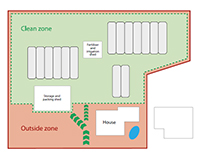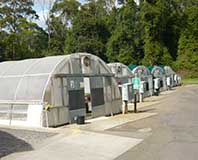Read the latest information on
Foot-and-mouth disease

Make a ‘clean’ zone around the greenhouse which is quarantined from the ‘outside’ zone of the farm (including houses and driveways). Anything entering the clean zone must be cleaned first.
Plant diseases in a typical greenhouse may cost as much as 15 per cent of potential income. Serious pest damage can take another 10 per cent from your bottom line.
Rod Turner, General Manger, Risk Management at Plant Health Australia, says that with figures like this being the norm, it’s worthwhile taking any measures you can to reduce the risk of introducing pests and diseases into your greenhouse.
“The good news is that your greenhouse profitability and productivity can be improved by minimising the losses caused by pests and diseases,” Rod said.
A useful guide to implementing biosecurity measures in your day-to-day activities is ‘Keep it clean: Reducing costs and losses in the management of pests and diseases in the greenhouse’, which was produced by NSW Department of Primary Industries and Hort Innovation staff working with around 115 greenhouse growers. It provides practical ways in which to introduce control strategies that greenhouse workers know from personal experience work to manage pests and diseases.
“Even though there are a lot of ways for pests and diseases to get into your greenhouse and affect your crops, there are clear, low cost and very effective ways to significantly reduce pest and disease problems.”
These can be broadly put into how your farm and greenhouse is set up and the work practices that you and your employees follow. Once established, the recommended practices are also very likely to reduce overall chemical and labour costs.

Maintain a 5-10 metre wide clean and clear buffer area around every greenhouse, which will significantly reduce the levels of pests entering from neighbouring paddocks, reduce spray applications and provide farms with all-weather access.
“Preventative management is about planning, cleaning and quarantining. You need to be organised, consistent and use a plan that is relevant to your farm set-up”, Rod said.
When it comes to pests and diseases, prevention is cheaper than treatment. Things like isolating new seedlings from main greenhouse until they have been through a quarantine period or treated to control a pest can save you from the added expense of treating an entire production area.
There are many other suggested ways in which to decrease the impact that endemic pests and diseases can have on your bottom line included in the guide.
Download your free copy from here.